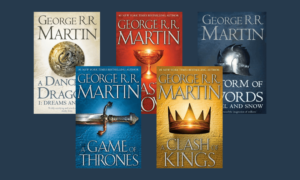Thrones in books represents far more than a story about power and politics it reflects a richly layered universe crafted by George R. R. Martin through his monumental series A Song of Ice and Fire. The novels have captivated millions of readers with their complex characters, moral ambiguity, and the unrelenting pursuit of the Iron Throne. Before the show became a global sensation, these books laid the foundation for an intricate world of alliances, betrayals, battles, and the timeless struggle for dominance.
Within these pages lies the true spirit of Westeros its lore, history, bloodlines, and wars depicted with a depth and scale that no adaptation can fully mirror. Exploring thrones in books allows readers to experience characters as they were originally imagined, with greater detail and richer context. It is a literary journey into a realm where power is fragile, loyalty is tested, and destiny is written in blood and fire.
Origins and Background of the Thrones in Books
Genesis of A Song of Ice and Fire
The foundation of thrones in books begins with George R. R. Martin’s vision in the early 1990s. He imagined a story of noble houses, political intrigue, and a kingdom constantly at war with itself. What started as a single book concept eventually expanded into a multi-volume epic known as A Song of Ice and Fire. The saga introduced readers to Westeros, a fictional realm inspired by medieval Europe yet infused with dragons, magic, and shifting alliances. Martin’s meticulous world-building made each region feel alive, with its own culture, traditions, and deadly rivalries surrounding the Iron Throne.
George R. R. Martin’s Inspirations
The author drew inspiration from real historical conflicts like the War of the Roses, ancient myths, and classic fantasy literature. Unlike typical fantasy tales of good versus evil, Martin wanted thrones in books to reflect the messy reality of human ambition. Every character, no matter how noble or cruel, carries a personal motive. This realism combined with high fantasy elements created a unique tone that continues to influence modern literature.
Publishing Timeline and Planned Volumes
The first novel, A Game of Thrones, was published in 1996, followed by A Clash of Kings in 1998, A Storm of Swords in 2000, A Feast for Crows in 2005, and A Dance with Dragons in 2011. Two more volumes, The Winds of Winter and A Dream of Spring, are anticipated to complete the series. This long timeline reflects Martin’s commitment to depth and quality, ensuring thrones in books remains a benchmark for epic fantasy storytelling.
Worldbuilding and Lore Foundations
The world of Westeros is built with extraordinary attention to detail from the cold North and the Iron Islands to the sands of Dorne and the Free Cities across the Narrow Sea. Houses like Stark, Lannister, Targaryen, Baratheon, and Greyjoy shape the politics of the Seven Kingdoms. Every map, sigil, prophecy, and war enriches the narrative tapestry. Thrones in books thrives because its setting feels tangible, evolving as the characters struggle for power.
Understanding the Iron Throne Concept in the Books
Symbolism of the Iron Throne
The Iron Throne is more than a seat; it’s a symbol of ultimate power in Westeros. Forged from the swords of defeated enemies, it represents both conquest and danger. Sitting on it is never truly safe both literally and politically. Within thrones in books, the throne mirrors the cost of ambition, where every decision can mean survival or ruin.
Its Significance Across the Series
Throughout the novels, the throne becomes the center of every plotline. Kings rise and fall, alliances are forged and broken, and entire houses perish in its name. From Robert Baratheon’s reign to the War of the Five Kings, the Iron Throne remains a constant reminder of the fragility of power. It defines the actions of countless characters.
Who Sits on the Throne? Key Claimants
Robert Baratheon, Joffrey Baratheon, Tommen Baratheon, Stannis Baratheon, Renly Baratheon, Daenerys Targaryen each plays a part in the bloody contest for the Iron Throne. But thrones in books also explores claimants who never sit on it but influence its fate through cunning, war, or betrayal.
Throne as Power, Not Just a Seat in Books
A Game of Thrones (Book 1)
The opening novel introduces readers to Westeros, the Stark family, and the early cracks in Robert Baratheon’s reign. Political intrigue escalates as Eddard Stark becomes Hand of the King, uncovering dangerous secrets. Meanwhile, across the Narrow Sea, Daenerys Targaryen’s destiny begins to unfold. This book sets the tone for the brutal struggle surrounding thrones in books.
A Clash of Kings (Book 2)
After Robert’s death, multiple factions rise to claim the Iron Throne. The War of the Five Kings consumes the realm as Stannis, Renly, Robb Stark, Joffrey, and Balon Greyjoy battle for dominance. Power fragments, alliances shift, and the realm descends into chaos.
A Storm of Swords (Book 3)
One of the most pivotal entries, this book delivers unforgettable events such as the Red Wedding and the Purple Wedding. Alliances collapse, new rulers rise, and Daenerys grows stronger across the sea. The stakes around thrones in books become more unpredictable than ever.
A Feast for Crows & A Dance with Dragons (Books 4 & 5)
These two novels run concurrently, focusing on different characters and regions. The power vacuum grows wider, and Daenerys takes control of Meereen. Jon Snow ascends to leadership at the Wall. Cersei’s grip on power begins to unravel. The Iron Throne stands at the heart of every move and betrayal.
Reading Order, Editions & Spin-offs
Chronological vs Publication Order
Most readers prefer the original publication order, which maintains the intended pacing and reveals. However, some choose chronological reading for a more linear experience. Both approaches highlight different facets of thrones in books.
Illustrated / Annotated / Special Editions
Over the years, illustrated and annotated editions have been released, adding visual depth to Martin’s words. These editions enrich the reading experience with maps, timelines, and character portraits, helping readers track the complex narrative.
Companion Works & Spin-off Novellas
Books like Fire & Blood and the Dunk and Egg novellas expand the lore of Westeros beyond the main saga. These spin-offs provide valuable context about House Targaryen, past wars, and legendary rulers.
The Upcoming Winds of Winter & Future Books
The highly anticipated Winds of Winter promises to push the story toward its long-awaited climax. Readers expect new alliances, battles, and betrayals, making thrones in books even more expansive.
Major Themes Related to Thrones in Books
Power, Legitimacy, and Succession
Power is the driving force of the saga. Every house claims legitimacy, but none can hold it forever. The Iron Throne symbolizes this endless cycle of conquest, inheritance, and rebellion.
Morality, Betrayal, and Ambition
Martin’s world thrives on moral ambiguity. Heroes fall, villains rise, and betrayals redefine the balance of power. This moral complexity makes thrones in books a masterclass in human psychology.
Identity, Lineage, and Bloodlines
Names, sigils, and blood determine a character’s fate in Westeros. Every noble house guards its legacy, and every secret bloodline can alter the realm’s future.
Fate, Prophecy, and the Supernatural
Dragons, White Walkers, and prophetic visions intertwine with politics, making Westeros a place where destiny and choice collide. Thrones in books seamlessly blends realism with myth.
Key Characters Around the Throne
House Stark, Lannister, Targaryen Dynamics
The three most influential houses shape the narrative. Starks represent honor, Lannisters ambition, and Targaryens legacy. Their conflicts and alliances keep the Iron Throne in constant turmoil.
Queen, King, Regent, and Usurpers
Every ruler faces challengers, and usurpers rise with every weak reign. Robert, Joffrey, Tommen, Stannis, Daenerys, and others shape the power struggle through leadership or war.
Supporting Characters Influencing the Throne
Littlefinger, Varys, Tyrion, Davos, and Olenna Tyrell demonstrate that power often belongs to those working behind the scenes.
Character Arcs Tied to the ks vs TV Adaptation
Plot Divergences and Omissions
The TV adaptation condensed or altered many storylines. Entire character arcs and subplots were left out, changing how the Iron Throne’s history unfolded for viewers.
Character Portrayals and Depth
Characters like Catelyn Stark, Tyrion Lannister, and Stannis Baratheon are given greater nuance in the books. Their motives and flaws are deeply explored, enriching thrones in books.
Timeline Shifts and Pacing
The show merged events and skipped years, while the novels take their time, creating a richer sense of political and emotional build-up.
Fan Reception & Authority of the Books
Many readers consider the novels the definitive version of the story, praising their complexity, layered storytelling, and consistency.
Why “Thrones in Books” Still Matters
Literary Richness Beyond Visual Spectacle
Unlike television, the novels offer unparalleled detail and depth, letting readers fully immerse themselves in Martin’s intricate world.
Influence on Modern Fantasy Genre
The success of thrones in books reshaped fantasy literature, inspiring countless authors to embrace morally complex characters and intricate political plots.
Fandom, Theories, and Community (Book-based)
Dedicated readers continue to debate theories, unravel prophecies, and analyze every clue, keeping the fandom vibrant long after publication.
Legacy, Future Expectations, and Impact
Even unfinished, the series has cemented itself as a cultural phenomenon, ensuring its influence will last for generations.
Tips for New Readers of Thrones in Books
How to Keep Track of Characters
With hundreds of characters, tracking names and allegiances can be daunting. Many readers use personal notes, maps, or chapter recaps to stay engaged.
Recommended Companion Resources (Maps, Glossaries)
Detailed maps and family trees enhance the reading experience. Understanding geography and house lineage makes thrones in books even more rewarding.
Reading Pace, Re-reads, and Annotations
Taking the series slowly allows readers to absorb its complexity. Re-reads often reveal hidden details missed the first time.
Avoiding Spoilers, Communities, and Safe Paths
Because the series is unfinished, spoilers can lessen the impact of big twists. Choosing spoiler-free communities can help preserve the reading experience.
Conclusion
Thrones in books stands as a timeless epic of power, ambition, and human complexity. Through George R. R. Martin’s storytelling, readers journey through a world where thrones define destinies and power shapes fates. Its pages hold the full depth of the Iron Throne’s history, the ambitions of great houses, and the ever-shifting tides of loyalty and betrayal. Long after adaptations have ended, the legacy of these novels continues to inspire, proving that the power of the written word remains unmatched in capturing the true heart of Westeros.



